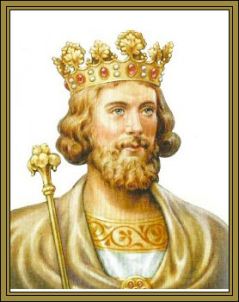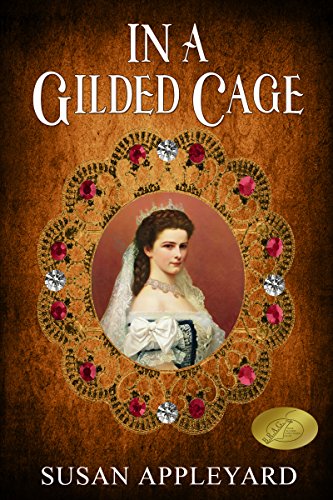
Piers Gaveston was born in Gascony c1284. Having taken a liking to the young man, Edward I placed him in the household of his son and heir, Edward of Carnarvon, as an example of the kind of man the king wanted his son to become: manly, athletic, likeable, and self-assured. They soon became fast friends. With others of their ilk, they were the ‘younger set’ at court, enjoying such pastimes as games, dancing, tournaments, and traipsing through the countryside in a long, colourful procession accompanied by minstrels. They regarded their fathers’ generation as dull and too serious. It was the son of a minor Gascon nobleman, not the prince, who was the leader of the group, the one they all wanted to be like.

This is a likeness of Gaveston. It’s unlikely to be a true likeness but it is how I always imagined him: dark hair, dark, soulful eyes, a generous mouth, and that little feature I just love, a dimpled chin. Kinda handsome. They must have made a lovely couple, one so fair, the other so dark.
In 1305, Edward had a falling out with his father and was banished from court and his allowance was cut off. The king reduced the size of his household, and Gaveston was one of those who was excised. This was hard for Edward to bear.
The two were united when Edward was knighted along with Gaveston and others the following spring. That same year Edward I launched a campaign against Scotland. (He was rather fond of making war.) And he ordered his son and Gaveston to accompany him. It was perhaps at this time that they became lovers. Two randy youngsters sharing a tent, denied the society of women, exploring… experimenting… curious. In any event, it is likely they did become lovers at some point, although some deny it.
When the king went into winter quarters, Gaveston and twenty-one other knights left the army to attend a tournament in France in spite of orders to the contrary. The king was enraged, and when he was mad wise men ducked for cover. He ordered the confiscation of the lands of all the knights involved. Eventually, he relented and pardoned the knights – all except one: Gaveston. In fact, Gaveston was punished by being sent into exile – not for the last time. In the decree of exile, no term was given, nor any cause. Of what was Gaveston guilty? Could it be that the king suspected the Gascon’s influence on his son was not what he had hoped for? Did the king separate them in the hope that his son would then change his ways? Edward of Carnarvon had an illegitimate son and was due to marry Isabella of France the following year, so it is certainly possible that his father cherished such a hope.
What do the chroniclers say of this matter? That the king’s love for Gaveston was ‘beyond measure and reason’, ‘immoderate’, ‘inordinate’ and ‘excessive’. Vita Edwardi Secundi: ‘I do not remember to have heard that one man so loved another… our king was… incapable of moderate favour’. Robert of Reading was starkly candid when he wrote that Edward indulged in ‘illicit and sinful unions’, and rejected the sweet embraces of his wife.
As it happened, Gaveston’s exile didn’t last very long because in the summer of 1307 King Edward I died. The new king lost no time in recalling his favourite and heaping him with honours. He was elevated to the Earldom of Cornwall and given Elizabeth de Clare in marriage. She was Edward’s niece and the sister of Gilbert de Clare, heir to the earldom of Gloucester. On top of all that, when Edward left for France to claim his bride, he named Gaveston as regent. The barons were outraged.
Isabella was the daughter of Philip IV (the Fair) of France. Although she was only twelve years old at the time of her marriage, she was probably enlightened in tactless and possibly vulgar terms about the relationship between her husband-to-be and the Gascon by her three older brothers. When she stepped ashore in England she was given a graphic demonstration of her husband’s love for Gaveston when Edward rushed down the gangplank and showered him with kisses, a show of affection Isabella most likely had not received. At the coronation a month later, Edward allowed Gaveston the most prominent role and at the feast later spent most of the time with his lover and all but ignored his wife. Isabella’s uncles were so offended by his behaviour they walked out.
In politics or war, Edward II was not the man his father was. Arrogant and provocative, Gaveston had offended a number of powerful barons and appeasement was the last thing on Edward’s mind. The barons managed to force Edward to send Gaveston into exile but again it was of short duration and Gaveston, arrogant as ever, resumed his dominant role at court and in the king’s affections.
Opposition mounted. In 1411 Edward had to acknowledge the Lords Ordainer, a group of 21 powerful nobles and bishops who drew up a set of rules to manage the royal household and the country. They also demanded that Gaveston be banished and never allowed to return. Now Edward was quite willing to hand his household and kingdom over to their rule if he could only keep his dear friend. The Ordainers were adamant. Gaveston must go. Go he did in November and was back the following January, Edward declaring that his banishment had been unlawful.
Civil war threatened. Led by the Earl of Lancaster, the barons gathered their forces. Edward and Gaveston almost fell into their clutches at Newcastle but managed to escape and fled to Scarborough. That was when Edward made the tragic mistake of leaving Gaveston there while he went to York. The barons besieged the castle and Gaveston surrendered to the Earl of Pembroke, who was generally regarded as an honourable man.
Unfortunately, when Pembroke left his prisoner in safe confinement and Gaveston was seized by the Earl of Warwick and carried off. From that moment his fate was sealed. He was thrown in a dungeon until Lancaster arrived. After a mock trial, he was taken to Blacklow Hill and stabbed before his head was cut off.

In the 19th century, a monument was erected on the spot where Gaveston was killed. The inscription reads in part: ‘the minion of a hateful king’ beheaded ‘by barons as lawless as himself.’
Not the best epitaph.
Next: the ‘minion’ who made Gaveston seem like a choirboy.
Piers Gaveston is a character in my latest book which, although finished 3 months ago I still haven’t found a title for. For the moment I will call it ‘The Rebel Queen.’
 I received this book from the author as a member of Rosie Amber’s Review Team., ‘#RBRT
I received this book from the author as a member of Rosie Amber’s Review Team., ‘#RBRT


